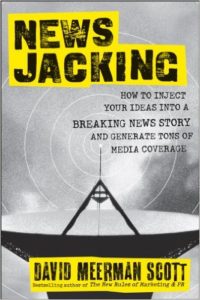
Top 100 Content Marketing Question: How do you repurpose content that is still valuable?
10 ways to repurpose existing content marketing and squeeze out more value
“How to or should you repurpose content that’s still valuable?” asked a marketer from Hiscox.
“How often does your content marketing need to change in order to still capture consumers?” asked a GlaxoSmithKline marketer.
These are two of the Top 100 Questions on Content Marketing. Find the answers here.

These questions point to your content marketing strategy. When you already have good evergreen content on your website, do you still need to create more brand-new content week after week, month after month?
Do you need to repeat the same content marketing again and again?
Maybe you don’t. Maybe you just need ways to freshen up the existing content. Why?
Because you can create more value by revisiting and repurposing existing content marketing rather than always creating new content.
If you’re afraid that your evergreen content marketing might be getting a little stale, how can you repurpose content, increase its value, and expand your audience?
10 ways to refresh, re-divide, re-envision, or remove existing content
Here are 10 ways to help you repurpose content.
Be sure to review your content at least once a year with these ideas in mind. With the new year ahead, it’s a good routine to practice now.
1. Refresh long-form content marketing with a rewrite.
Do you have good long-form content marketing such as white papers and e-books? If so, consider these actions:
- Write snappy new benefit-laden headlines. A/B test old vs. new headlines.
- Add an executive summary of 3 sentences upfront. In boldface.
- Add subheads, bullets, call-outs, and white space to boost scannability on a PC or cell phone.
Taking this approach helped HP increase traffic to its existing long-form content by more than 30%.

2. Refresh evergreen content by adding a news hook.
Have recent stories in your industry evolved to affect your customers’ point of view? If so, consider these actions:
- Monitor industry news coverage on key topics with a news alert such as Google News. When a story breaks, cite it in social media in real-time, then point to your existing content with a link.
- When news on a relevant topic appears, write a new lead paragraph for existing content that refers to the news and adds a link to it.
- Express your company’s point of view about news stories. Is the story good for customers? Why or why not?
- “Newsjack” stories from competitors. Whatever the bad guys say in the news today, assert your company’s point of view. Add insightful comments to their story in real-time. Here’s a book, Newsjacking, by David Meerman Scott that shows you exactly how:

3. Refresh by improving content readability.
You can test the readability of your content marketing by using a readability test.
To improve readability, simplify your text. Use shorter words, shorter sentences, and shorter paragraphs.
Simplify the text to attain a lower Flesch-Kincaid grade level. The lower the grade level, the larger the audience of people who can read and comprehend your website.
For example, in the technology space, many websites are written at a 17th-grade level.
Why is that a problem? Here’s the math:
- If your text reads at a 17th-grade level, only 1% of Americans can comprehend it.
- If your text reads at the 8th-grade level, half of Americans can comprehend it.
- This blog reads at a 7.2-grade level, so most Americans can comprehend it.
- Remember that many people speak English as a second language. The simpler the words you use in content marketing, the larger your addressable audience becomes. That’s the secret of using global English.
4. Re-divide: Combine short-form content to create long-form content.
Collect short-form content until you have enough to create long-form content.
- If you’ve been Tweeting on a topic, round up your top 5, 10, or 20 Tweets to create a new piece of content.
- Mashup existing videos to create a new, longer video.
- Combine 10 blogs on a topic into an e-book or white paper.
- Collect 100 blogs and turn them into a book.

5. Re-divide long-form content into short-form content.
Starting with long-form content such as a 10-page white paper, convert it into short-form content such as:
- 10 two-minute blogs
- 4 five-minute articles
- A series of two-minute videos
- A set of infographics.
Read long-form content with a highlighter in hand. Find pithy sentences and phrases worth Tweeting. Tweet them to point people to your long-form and short-form content.
6. Re-envision: add images to existing content marketing.
Most people scan web content. They don’t really read it. On average, only about one-fourth of text on a web page is read.
That’s because more than half of people spend less than 15 seconds active on a webpage.
To pull in readers, add images to text pages, about one per screen depth. Images invite scanners to keep moving down the page. Include captions with each image, since captions are highly read content.

7. Re-envision content to make it visual or audio first, text second.
If your content marketing web pages are text-heavy, lighten up. Show or say before you tell.
Visuals and audio are the new headlines. Take license to turn text into charts, graphs, images, photos, and infographics.
The most-read elements on a webpage are the headline, image, and caption below the image. To enhance the meaning of images, include captions that amplify your story — since they’re highly likely to be read.
8. Re-envision photos as videos.
You can easily transform still images into videos with a voiceover. People who won’t look at text-y web pages may be willing to watch and listen to your short video instead.
Why videos? The easier your content is to consume, the more likely people will consume it.
9. Remove web pages from your site.
Even on large websites with hundreds of pages, oftentimes 10 to 20 pages generate 80% or more of the traffic. Some pages generate almost none.
Why keep them?
Consider removing the bottom 20% to 33% of the content from your website.
Removing content is especially important when you plan to relaunch a website. There’s no need to bring along all your old baggage on the next trip.

10. Remove obsolete ideas from existing content.
Every year, gardeners remove deadwood from trees and bushes because it inhibits growth. Similarly, you need to get the deadwood off your website.
When the technology changes, the product information becomes obsolete, or the subject-matter experts leave the company, cut out the content that pertains to them.
Then freshen it up with information about the new technology, the new product, or the new subject-matter expert.
These 10 approaches will help you get the most out of content marketing you’ve already created.
You’ll make it look fresh and new to content users – increasing the odds they’ll explore more of your content marketing.
Before you create any new content asset, make sure you’ve squeezed all the value out of the content you already have. That’s a good content marketing strategy.
“How often does your content marketing need to change in order to still capture consumers?” and “How do you repurpose content that is still valuable?” are two of the Top 100 Questions that content marketers ask about content marketing strategy.
This is based on our exclusive text analysis of more than 2,000 questions that marketers asked during our content marketing workshops.

